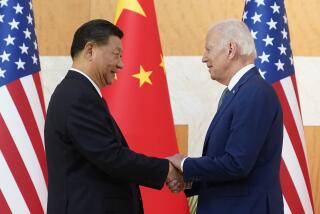Live Exchange on Tibet Seen as a Stunning, if Puzzling, Success
- Share via
BEIJING — In the eight months since President Clinton’s foreign policy team elevated religious freedom and human rights in Tibet to a priority issue in Washington’s prickly relationship with China, visible progress has been virtually zero.
Prospects for any kind of breakthrough during Clinton’s nine-day trip to China were considered so bleak that the State Department’s recently created post of Tibet policy coordinator, occupied by Gregory Craig, was not even a part of the 200-strong American delegation for the trip. And the 14-page document titled “Achievements of the U.S.-China Summit” issued Saturday after Clinton’s meeting with Chinese President Jiang Zemin does not mention the word “Tibet.”
Then came the extraordinary news conference between the two leaders, and suddenly, amid the unscripted public exchanges on the most sensitive of issues that divide the two countries, Tibet burst into the spotlight.
Responding to Clinton’s opening statement that included a call for China to open a dialogue with Tibet’s spiritual leader, the Dalai Lama, in return for the Dalai Lama’s pledge to accept that Tibet is part of China, Jiang declared a conditioned readiness to do just that.
“Actually, as long as the Dalai Lama can publicly make the statement and a commitment that Tibet is an inalienable part of China, and he must also recognize Taiwan as a province of China, then the door to dialogue and negotiation is open,” Jiang said.
While Jiang repeated his routine denunciation of followers of the Dalai Lama during the news conference, he conspicuously omitted the personal attacks on the Dalai Lama himself that almost always accompany Chinese statements on Tibet.
Clinton, who knows both leaders well, concluded the news conference by describing the Dalai Lama as “an honest man” and suggesting that if Jiang met the Tibetan leader, “they would like each other very much.”
U.S. officials, clearly caught off balance by the spontaneous exchanges, were reluctant to assess their possible longer-term impact.
The Dalai Lama has already come close to declaring Tibet a part of China, disavowing any immediate aspiration for independence. And while Jiang’s call for him to recognize Taiwan as a Chinese province is a new demand, U.S. officials did not see the condition as insurmountable.
“It’s puzzling, but I don’t think it’s a showstopper,” a White House official said. Followers of the Dalai Lama had a similar initial reaction.
At a Chinese government news conference later in the day, Foreign Ministry spokesman Zhu Bangzhao quickly fell back to more normal practice, dismissing the Dalai Lama as one who “wants to split the motherland” and who is the central obstacle to improving conditions in Tibet.
Still, for Tibetan activists, Saturday’s public comments by Chinese and American leaders--on an issue whose very mention has long been considered by the Chinese as taboo--were nothing short of a stunning success.
That the exchanges unfolded in China live and apparently uncensored to television and radio audiences estimated in the hundreds of millions merely added to the sweetness of the moment.
“We’re very pleased that there’s an open and public debate on Tibet,” said John Ackerly, president of the Washington-based International Campaign for Tibet, a nonprofit organization that supports the Dalai Lama’s cause. “After all these years, we’re especially glad that Tibetans themselves could see this. They’ve worked long and hard to get the issue to this level, and it’s there now.”
Awareness of the Tibetan struggle for greater political and human rights has gradually gained a greater public profile in the United States, especially among young people, spurred by a series of films, including historical Hollywood extravaganzas “Seven Years in Tibet” and “Kundun,” and a more recent, modest effort by the Virginia-based filmmaker Paul Wagner, titled “Windhorse,” that focuses on the contemporary struggle for human rights in Tibet.
Earlier this month, a weekend rock concert promoting the Tibetan cause drew overflow crowds into RFK Stadium in Washington, D.C.
The Clinton administration’s decision to push actively on the long-dormant issue of Tibet stems in part from Secretary of State Madeleine Albright’s intense interest in human rights.
However, when she raised Tibet during a half-hour meeting with Jiang in May, she was reportedly treated to an extended lecture.
The administration had sought both the release of at least some Tibetan prisoners held in Chinese prisons and the opening of a new dialogue between the Chinese regime and the Dalai Lama.
As the summit neared, expectations were gradually lowered to negotiating a series of confidence-building measures that might pave the way for talks between the Chinese government and the Dalai Lama.
The Dalai Lama escaped a Communist Chinese crackdown in 1959 by fleeing to India, where he has lived since.
Barely 24 hours before Saturday’s presidential news conference, Clinton’s national security advisor, Samuel R. “Sandy” Berger, said that “we have made a number of suggestions relating to . . . Tibet” in talks with the Chinese regime.
However, he added, “I would not anticipate that we would see the fruits of those discussions while we are here.”
More to Read
Sign up for Essential California
The most important California stories and recommendations in your inbox every morning.
You may occasionally receive promotional content from the Los Angeles Times.













